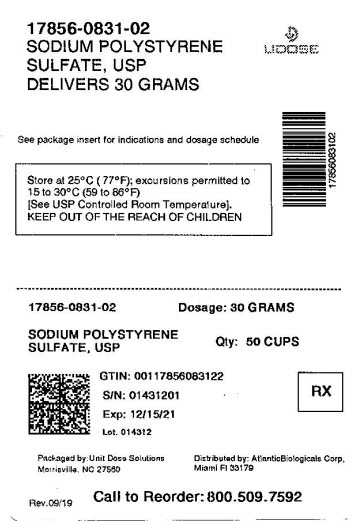Sodium Polystyrene Sulfonate
Sodium Polystyrene Sulfonate Powder for Suspension Cation - Exchange Resin Rx only
af0a64e1-4fde-4320-93a7-7801a03b7613
HUMAN PRESCRIPTION DRUG LABEL
Jul 30, 2025
ATLANTIC BIOLOGICALS CORP.
DUNS: 047437707
Products 1
Detailed information about drug products covered under this FDA approval, including NDC codes, dosage forms, ingredients, and administration routes.
Sodium Polystyrene Sulfonate
Product Details
FDA regulatory identification and product classification information
FDA Identifiers
Product Classification
Product Specifications
INGREDIENTS (1)
Drug Labeling Information
PACKAGE LABEL.PRINCIPAL DISPLAY PANEL
PRINCIPAL DISPLAY PANEL - 4.1mEq jar
NDC 17856-0831-1 Rx Only
Sodium Polystyrene
** Sulfonate, USP**
Average adult dose: 15 g (approximately 4 levelTeaspoons) one to four times
daily in water. See complete prescribing information.
The effect must be carefully controlled by frequent serum potassium
determinations within
each 24 hour period. Sodium content approximately 60 mEq per 15 g.
Suspension should be freshly prepared and not stored beyond 24 hours.
Dispense in tight, light-resistant containers as defined in the official
compendia.
Store at 25° C (77° F); excursions permitted to 15 to 30° C (59 to 86° F) [see USP Controlled Room Temperature]
15G (1 lb)


DISTRIBUTED BY: ATLANTIC BIOLOGICALS CORP. MIAMI, FL 33179
HOW SUPPLIED SECTION
HOW SUPPLIED
Sodium polystyrene sulfonate is available as a cream to light brown, finely ground powder in jars of 1 pound (453.6 g),NDC51293-831-97
Store at 25° C (77º F); excursions permitted to 15° - 30° C (59° - 86° F) [see USP Controlled Room Temperature]
DISTRIBUTED BY:
ATLANTIC BIOLOGICALS CORP.
20101 N.E 16TH PLACE
MIAMI, FL 33179
DOSAGE & ADMINISTRATION SECTION
DOSAGE AND ADMINISTRATION
Suspension of this drug should be freshly prepared and not stored beyond 24 hours.
The average daily adult dose of the resin is 15 g to 60 g. This is best provided by administering 15 g (approximately 4 levelteaspoons) of sodium polystyrene sulfonate one to four times daily. One gram of sodium polystyrene sulfonate contains 4.1 mEq of sodium; one level teaspoon contains approximately 3.5 g of sodium polystyrene sulfonate and 15 mEq of sodium. (A heaping teaspoon may contain as much as 10 g to 12 g of sodium polystyrene sulfonate.) Since the in vivoefficiency of sodium-potassium exchange resins is approximately 33 percent, about one third of the resin's actual sodium content is being delivered to the body.
In smaller children and infants, lower doses should be employed by using as a guide a rate of 1 mEq of potassium per gram of resin as the basis for calculation.
Each dose should be given as a suspension in a small quantity of water or, for greater palatability, in syrup. The amount of fluid usually ranges from 20 mL to 100 mL, depending on the dose, or may be simply determined by allowing 3 mL to 4 mL per gram of resin. Healthcare professionals should follow full aspiration precautions when administering this product, such as placing and maintaining the patient in an upright position while the resin is being administered.
The resin may be introduced into the stomach through a plastic tube and, if desired, mixed with a diet appropriate for a patient in renal failure.
The resin may also be given, although with less effective results, in an enema consisting (for adults) of 30 g to 50 g every six hours. Each dose is administered as a warm emulsion (at body temperature) in 100 mL of aqueous vehicle. The emulsion should be agitated gently during administration. The enema should be retained as long as possible and followed by a cleansing enema.
After an initial cleansing enema, a soft, large size (French 28) rubber tube is inserted into the rectum for a distance of about 20 cm, with the tip well into the sigmoid colon, and taped in place. The resin is then suspended in the appropriate amount of aqueous vehicle at body temperature and introduced by gravity, while the particles are kept in suspension by stirring. The suspension is flushed with 50 mL or 100 mL of fluid, following which the tube is clamped and left in place. If back leakage occurs, the hips are elevated on pillows or a knee-chest position is taken temporarily. A somewhat thicker suspension may be used, but care should be taken that no paste is formed, because the latter has a greatly reduced exchange surface and will be particularly ineffective if deposited in the rectal ampulla. The suspension is kept in the sigmoid colon for several hours, if possible. Then, the colon is irrigated with nonsodium containing solution at body temperature in order to remove the resin. Two quarts of flushing solution may be necessary. The returns are drained constantly through a Y tube connection. While the use of sorbitol is not recommended, particular attention should be paid to this cleansing enema if sorbitol has been used.
The intensity and duration of therapy depend upon the severity and resistance of hyperkalemia.
Sodium polystyrene sulfonate should not be heated for to do so may alter the exchange properties of the resin.
DESCRIPTION SECTION
DESCRIPTION
Sodium polystyrene sulfonate is a benzene, diethenyl-polymer, with ethenylbenzene, sulfonated, sodium salt and has the following structural formula

The drug is a cream to light brown finely ground, powdered form of sodium polystyrene sulfonate, a cation-exchange resin prepared in the sodium phase with an in vitroexchange capacity of approximately 3.1 mEq ( in vivoapproximately 1 mEq) of potassium per gram. The sodium content is approximately 100 mg (4.1 mEq) per gram of the drug. It can be administered orally or in an enema.
